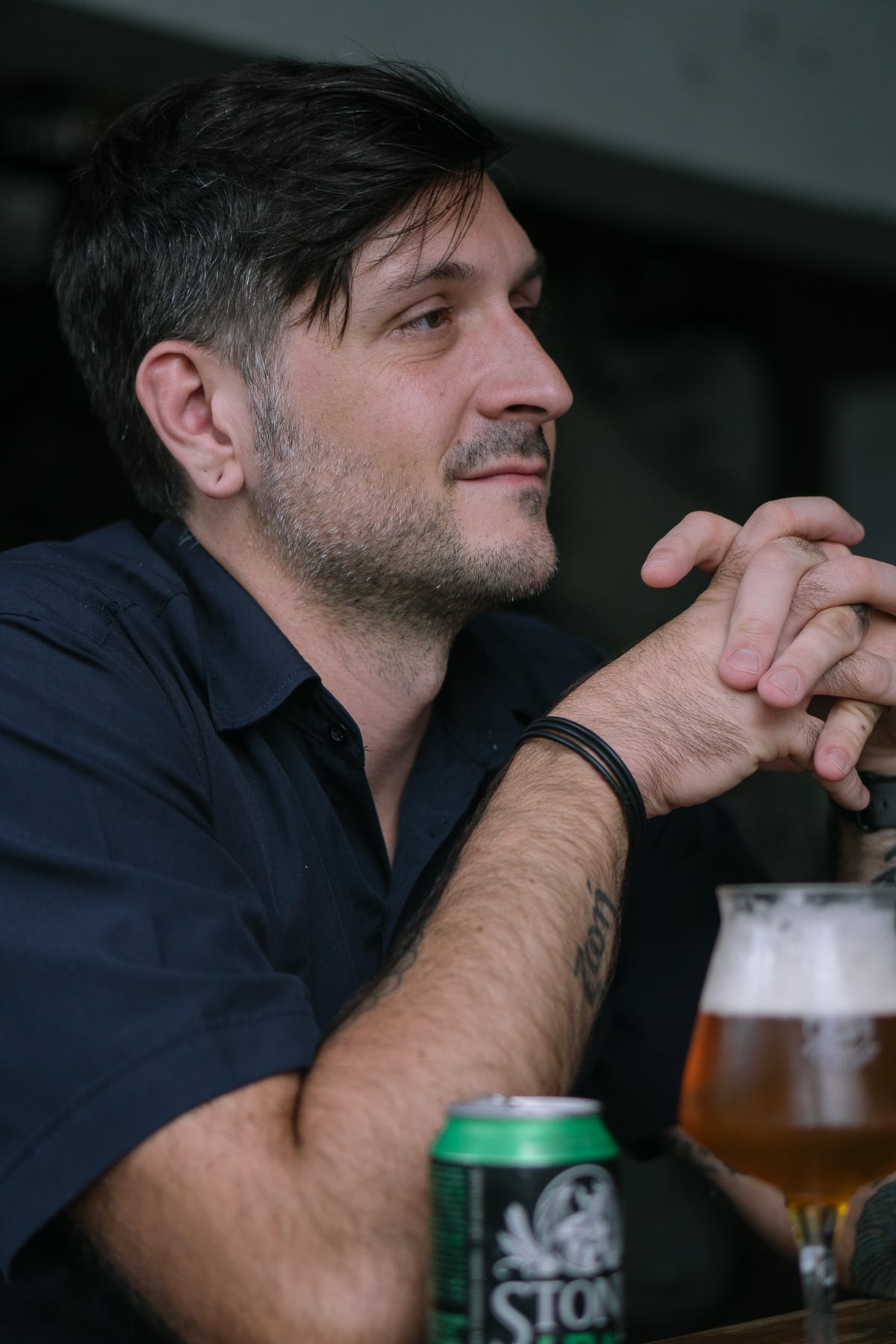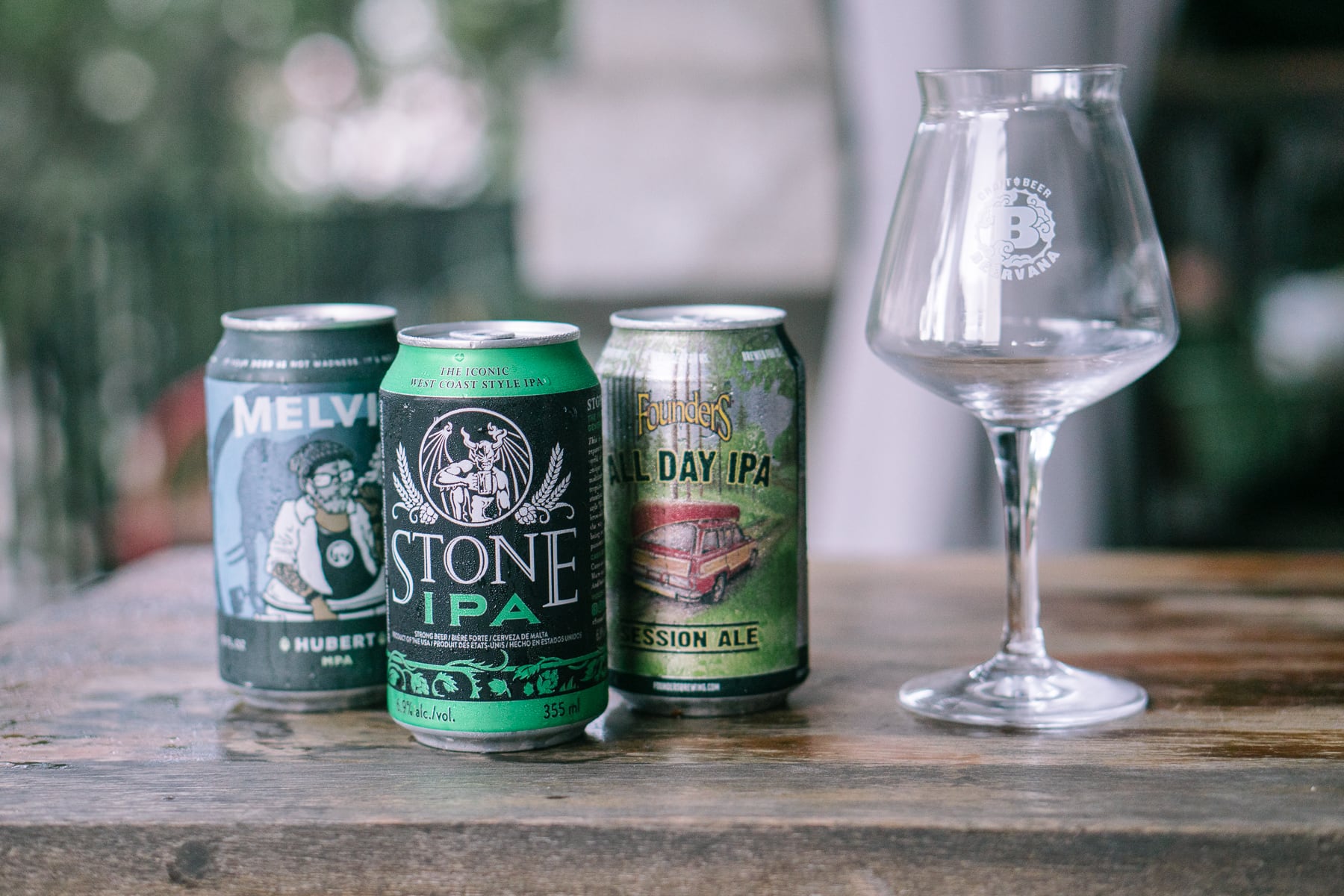Beervana has been sniffing out impressive international craft beers and importing them to Southeast Asia since 2012. During that time, they’ve also been busying themselves throwing massive bashes and, more importantly, working to welcome Asian consumers to join the global craft beer revolution.
It’s raining heavily when we meet Beervana’s global frontiers director Chad Mitchell at Rogue Saigon, but that doesn’t stop us from going up to the rooftop to have a conversation about our favorite thing in life—craft beer. One of Beervana’s co-founders Brian Bartusch can’t make it in person, but we bring him into the interview online so he can share his thoughts too.

Although they weren’t officially open yet, Rogue’s bar manager Quan Pham was happy to accommodate our early arrival. In fact, Pham helped to start the craft conversation by bringing us two Lava Red Ales from HCMC-based LAC Brewing Co—on the house. Vietcetera wanted to understand the tricky process of cold-chain while picking Chad and Brian’s brains about what kind of craft beer madness they have brewing for Vietnam, Beervana’s newest interntional craft beer distribution market.
How did Beervana get its start in Asia back in 2012?
Brian: The other co-founder, Aaron Grieser, was a corporate lawyer who put his tie back on the rack to follow his passion for craft beer. He was always complaining about missing good craft beer—a yearning that ultimately grew into a career in the industry. The first step for Beervana was Grieser’s craft beer pilgrimage to America’s Pacific Northwest. His aim was to find breweries interested in exporting to the Asian market. During his visit, he managed to convince heavy-hitters like Rogue Ales from Oregon and California-based Anderson Valley Brewing Company to let him export some of America’s most cherished craft beers into, what was then, uncharted terrain.

Taking craft beer across the world without sacrificing quality required Aaron Grieser to find a solution to the biggest problem facing the exportation of craft beer—cold-chaining. For Beervana, the answer was simple; to create their own cold-chain logistics network, ensuring not a single particle of craft beer would be compromised.
After they could guarantee quality control, Rogue Ales provided Beervana with the rights to export Dead Guy Ale. Shortly after, Anderson Valley Brewing followed suit and gave them the green light to export six of their brews to Thailand.
Chad Mitchell even delivered himself during one of his first regional shipments, riding on a long tail boat with coolers for a delivery to Phi Phi island. He had to be sure his babies—the craft beers—were kept cold until he saw them put into the refrigerator. If the temperature is off by a small margin, the entire shipment could be compromised. Perhaps, it’s this kind of obsessive attention to quality and detail that led to the multi-national success Beervana enjoys today.
Why did you pinpoint Vietnam as your next location for distribution? You have already been importing to Thailand and Indonesia for some time now.
Chad: We were talking about expanding our network to Vietnam, and nobody else was making any moves yet. So, naturally, we saw a gap in the market. Grieser was already acquainted with Quan Ut Ut’s co-founders Tim Scott and Mark Gustafson when he came over for their first lauch party a few years ago. Nobody had any idea that they (and a few others) were about to unroll a new chapter in Vietnam’s history with the introduction of craft beer.
We had eyes on Vietnam’s craft beer scene early on and we were impressed with how much momentum the scene acquired in such a short time frame. I also read about Vietnam’s craft explosion on Munchies and CNN. We wanted our team to build a relationship with Vietnam’s key players. The next step brought Brian and I to Ho Chi Minh City for SEA Brew’s conference in August 2017.

At SEA Brew’s conference we met John Pemberton from Heart of Darkness Craft Brewery and Mischa Smith from Pasteur Street Brewing Company. That was how we got our footing in Vietnam. The rest just fell into place.
How does Vietnam’s craft beer industry compare to other countries in the region?
Brian: Nobody can argue that the craft beer industry in Vietnam is a force to reckoned with. Although Vietnam’s market is centered around local craft breweries, most other countries in Southeast Asia still have far more imports than local breweries.
The “bia hoi” phenomenon is a good example of how much Vietnam loves beer. The country’s affinity for beer runs much deeper than all its neighbors. Just look at the data. As of 2018, South Korea is the only country in Asia that consumes more alcohol than Vietnam, and experts are projecting that Vietnam will easily overtake Korea by 2020.
Chad: Vietnam-based brewers were more concerned about developing their own brands of beer, rather than dealing with the logistics of importation. But for other countries in the region, importation was the catalyst for craft beer industry growth. What Vietnam has done is an incredible feat. Even America’s craft beer revolution was a direct result of importation. Belgian beers were introduced and then American brewers leveraged that knowledge and created their own style of craft beers. They quickly made an industry out of it.

What role do you wish to play in Vietnam as the industry grows?
Chad: By the end of this year Beervana will introduce 24 new craft imports from five international brands to Vietnam. We’ll also be introducing new styles and draft beer from Rogue Ales and Anderson Valley Brewing Company. Looking forward to 2019 there’s even more coming, but I will let you find out about that later.
How much room is there for more craft beer in Vietnam? Is oversaturation a concern?
Some people think there is a cap for the industry and believe it will soon be oversaturated. That’s simply not true. There are roughly 6,655 breweries and rising in the US alone. I think that is proof there’s plenty of room for more.
We believe a rising tide floats all boats. By importing our favorite craft beers to Vietnam we wish to join the local community and help the Vietnamese craft beer revolution reach unprecedented heights. The market potential is limitless.

Vietnamese consumers have unique taste profile preferences. How do you decide which beers are best fit for this market?
Brian: This is the fun part of an ongoing process. We started with a pretty aggressive portfolio in the sense that most of our beers are hop-forward and higher in alcohol than many local brews. We hope to refine our catalog as we learn more about Vietnamese taste profiles and drinking habits. However, we also want to challenge their sense of taste.
I’m confident that after some time the local Vietnamese population will take to a wider range of styles and profiles. They are well-known for gravitating towards bold flavors. We want to throw something at them they’ve never tasted before and watch them go crazy…just like the first time we tried those same beers.
In the beginning, I’m sure many thought craft beer wouldn’t work in Southeast Asia. Did people think you were chasing a pipe dream?
Chad: It’s funny. When we first introduced craft beer to Asian markets lots of people said things along those lines. They thought IPAs and sours wouldn’t work. Others said craft beer in general is simply too expensive for the region.
As a way to introduce locals to craft we figured the best way to accomplish this was to throw lots of parties. I mean, that’s how we first learned about craft beer. Once we put cold craft beer in people’s hands, and let a little time pass, it just clicks for many. It doesn’t matter if you are familiar with the product in the beginning. It’s our job to educate you, and give you the chance to explore. Giving consumers firsthand experience with craft beer is more important than trying to predict which styles will work beforehand. Just let them try it and ask them what they think about it!

How do you ensure all your craft beer is properly cold-chained across the world?
Brian: Stone Brewing uses cold-unit technology that tracks temperature every few minutes. When fresh unpasteurized beer is stored at the wrong temperature the flavors decrease rapidly. This is why we pay more for refrigerated containers and ask the breweries to secure temperature trackers in each shipping unit. We can then plug these in and see the exact temperatures the beers were stored in when shipping overseas. This is the best way to guarantee quality control.
Once brewers finish a beer it’s immediately stored in cold warehouses, delivered in cold trucks, and put in a refrigerated shipping container. Once it is taken off the shipping container, we ship it at the correct temperature until it hits the bar’s cold storage units.
Part of our success requires us to educate our clients on why the beer needs to be kept cold at all times. This requires refrigeration on-site at every venue and chilling systems for all draft beer. We know that many smaller venues might not have this equipment so we’re willing to provide proper appliances to keep the beer cold and fresh. We also manage and carefully rotate our inventory to ensure our stock is in order as well.
What are some insider tips regarding the process of cold chain you’d give to breweries in Vietnam wanting to export?
Brian: The most important thing you need to do is to make sure your beer is 100% cold-chained from point “a” to point “b.” The beer must be stored at the optimal temperature the entire time—every minute counts.
Chad: Before you even think about exportation you’d better be confident that you’re brewing the best fucking beer possible. Then you must follow up with your distributors and build strong relationships. You have to trust them if you don’t have your own international distribution system. Find someone that cares about craft beer as much as you do. Yes, local breweries in Vietnam should be looking towards exportation, but only when they’re truly ready. They could potentially do more damage than good to their brand by sending out beer that isn’t cold-chained properly.

Which imports have you brought in to Vietnam already? Where can people find them?
Chad: We have several imports from Stone Brewing, Melvin Brewing, and Founders Brewing Company across numerous outlets around Ho Chi Minh City. You can find them at Saigon Craft, BiaCraft, Brewlliant, Rehab Station, Quan Ut Ut, and Malt.
What is “beervana” to you? Are we there yet? If not, what’s the next step to achieving “beerlightenment”?
Brian: I like to think of “beervana” as a transcendent state of mind brought on by the flavors of an incredibly brewed craft beer. When you experience a beer with a profile you haven’t tasted before, there is a moment when you forget everything else in the world exists. The only reality is the taste you are experiencing in that moment. It’s pleasantly overwhelming, especailly in the beginning of your craft beer journey.
“Beerlightenment” isn’t a destination or place, but an ongoing process. Beer geeks will spend untold hours and lots of money to experience those moments when the taste of a craft beer is the only reality. If you’re an experienced drinker, you will always be chasing that feeling when you had that first sip of craft beer. When that light bulb flicks on there’s no turning back.

This is actually what keeps all of us doing what we’re doing. It’s a collective drive to achieve that state of mind again and again. When you understand enough about craft beer you can decide to go to that happy place anytime you want. You just need to know where to get the right beer.
Chad: “Beerlightenment” is our way of giving back to the world. Exploring craft beer is our passion, our life, our job, and our favorite hobby.
Related Content:
[Article] Craft Beer In Vietnam: A Guide To Vietnamese Artisanal Brew
[Video] BiaCraft Curates 4 Craft Brews For The Summer Season
